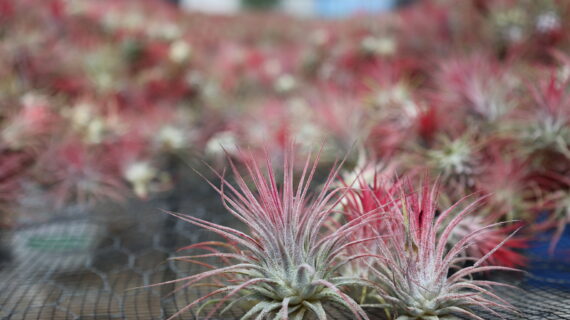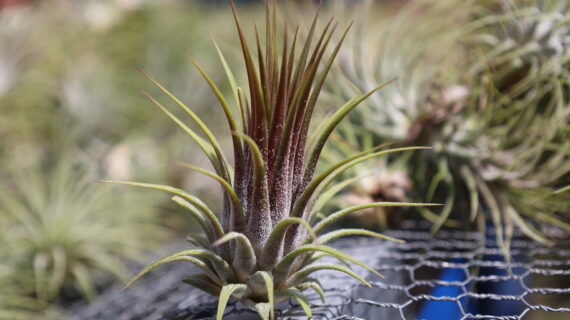
illandsia, commonly known as air plants, are unique in the plant world due to their ability to thrive without soil. Unlike most plants that rely on roots to absorb nutrients and water from the soil, air plants have developed an extraordinary way to survive using specialized structures called trichomes. These tiny, hair-like cells play a crucial role in their ability to absorb water and nutrients directly from the air. But how exactly do they work? Let’s explore the fascinating role of trichomes in Tillandsia and how they enable these incredible plants to live and thrive.
What Are Trichomes?

Trichomes are microscopic, hair-like structures that cover the surface of Tillandsia leaves. Though they may not be visible to the naked eye, they serve as the plant’s lifeline, helping it gather water and nutrients from its surroundings. These trichomes are made up of specialized cells that can absorb and store moisture and nutrients, allowing Tillandsia to survive in environments where soil and consistent water sources are scarce.
Types of Trichomes
While trichomes can vary in appearance and function across different plant species, in Tillandsia, they are specialized for a very unique purpose: epiphytic survival. Most air plants are epiphytes, meaning they grow on other plants, rocks, or surfaces, without depending on soil for nourishment. Their trichomes are adapted to:
- Trap Moisture: They pull in water droplets from rainfall, mist, or even humidity in the air.
- Capture Nutrients: In the wild, trichomes can also trap dust particles, organic matter, and nutrients present in rainwater or air.
- Reflect Sunlight: Trichomes help reflect excess sunlight, protecting the plant from harsh UV rays and preventing water loss from evaporation.
How Trichomes Absorb Water and Nutrients

The process of water and nutrient absorption in Tillandsia is fascinating, as it takes place entirely through the plant’s leaves, bypassing the root system altogether. Here’s a closer look at how trichomes make this possible:
Water Absorption
In most plants, roots are the primary system for water uptake, but in air plants, the leaves take over this critical role. Here’s how it works:
Water Collection: When the air is humid, or during rainfall or misting, the trichomes on the surface of the Tillandsia leaves spring into action. They absorb water droplets directly from the air.
Swelling of Trichomes: As the trichomes absorb water, they swell and flatten, creating a moist surface on the leaf that allows water to be transported to the plant’s internal tissues.
Water Distribution: Once the trichomes capture the water, it is slowly distributed throughout the plant’s tissues, providing the necessary hydration for metabolic processes.
Nutrient Absorption
Tillandsias live in nutrient-poor environments, which means they must rely on their surroundings for essential minerals. In their natural habitats, air plants might grow on trees, cliffs, or even telephone wires, gathering nutrients from various sources, such as decomposing organic matter, dust, and rain.
Nutrient Capture: Trichomes can trap microscopic particles of organic material or dust from the air. When rain or mist occurs, these particles dissolve and are absorbed along with the water.
Storage of Nutrients: Trichomes can also store nutrients like nitrogen, phosphorus, and potassium, which are essential for the plant’s growth and health. These nutrients are taken in through the trichomes and are gradually used to support new growth and flowering.

Environmental Adaptation and Survival
The unique structure and function of trichomes have allowed Tillandsias to adapt to a wide range of environments. From tropical rainforests to arid deserts, air plants are versatile survivors thanks to their ability to absorb moisture and nutrients from the air.
Thriving in Harsh Conditions
In environments where water is scarce, Tillandsias rely on high humidity levels or sporadic rainfall for survival. For example, in desert-like conditions, where rain is infrequent, trichomes allow the plants to take advantage of even the tiniest amount of moisture in the air. Additionally, trichomes reflect sunlight, preventing the plant from overheating and losing too much water to evaporation.
Different Species, Different Trichomes
Some species of Tillandsia have more pronounced trichomes than others, depending on their native environment. For example:
- Tillandsia Xerographica, native to arid regions, has thick, fuzzy trichomes that help it collect moisture in a dry climate.
- Tillandsia Bulbosa, which is native to more humid environments, has smoother leaves and fewer trichomes since water is more readily available in the air.
Caring for Tillandsia at Home
Understanding how trichomes work can help you provide better care for your Tillandsia. Here are a few care tips based on the role of trichomes:
Watering: Misting or soaking your air plants mimics the natural rainfall they would receive in the wild. Ensure your Tillandsia dries completely after watering to prevent rot.
Humidity: Air plants thrive in humid environments. Consider placing them in naturally humid areas like the bathroom or kitchen, or use a humidifier to increase moisture levels.
Air Circulation: Good air circulation is crucial. Just as Tillandsias benefit from breezes in the wild, they need airflow at home to help them dry out and stay healthy after absorbing water.
Trichomes are the unsung heroes of Tillandsia, enabling these unique plants to survive and thrive in environments where soil is not an option. By understanding the vital role trichomes play in water and nutrient absorption, you can better appreciate the fascinating biology of your air plants and provide them with the care they need to flourish in your home. From misting your plants to ensuring good air circulation, you’re now equipped to help your Tillandsias thrive by supporting their natural abilities.